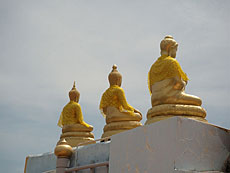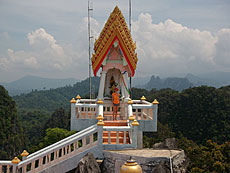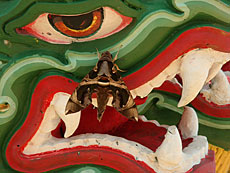Ao Nang - Climb to the Tiger Cave Temple
The Tiger Cave Temple or in Thai "Wat Tam Seua" is considered by Krabi's Bhuddists to be one of the most sacred sites in the province. Even for those who are not religiously inclined there are some fascinating sights here, which are well worthy of a visit. This can include either a moderately strenuous or a very strenuous climb, depending on which of two staircases you choose.
The view from the top, combined with the lovely Bhuddist statuary, makes the summit of the hill an unforgettably beautiful place. Sunset ascents are becoming increasingly popular, especially at a full moon, when it is possible to see the sun setting the islands in the Andaman Sea on fire in the west, while a golden moon rises over the Krabi lowlands in the east. The cave temple is aptly named because of the rock outgrowth nearby, which resembles a tiger's claw.
This is a great place to visit on a day-trip combined with some elephant trekking at Phanom Bencha National Park. The full daytrip costs THB 1,500 per adult and THB 900 per child, including hotel pickup and dropoff, entrance fees and lunch.
Contact us to book. Read on for more information about the fab Tiger Cave Temple, Krabi province's more prominent beacon for the love and hope of the religion it represents.
Tiger Cave Temple is a center for meditation : its spectacular setting in the Ao Luk Thanu mountain ranges provides the necessary quiet atmosphere for meditation. The main vihara or the holy of holies is inside a small shallow limestone cave. Both sides are lined by monastic cells, like caves, which are called kutis.
The area is well lit and very well maintained, so preserving the serenity of the environment. Some 250 monks and nuns live in the temple compounds at the moment. This little forest reserve was spared from logging by the monks ordaining the largest trees and thereby thwarting any attempts at logging.
For a naturalist the site is a microcosm of Krabi's former natural environment. "Wonderful Tree", not far from the main shrine and adorned in sacred cloth, may well have the largest root base of any tree remaining in Thailand. The whole area is full of caves and limestone rock formations. Archeologists have found remnants of ancient habitations as old as from the stone age. Stone tools, shards of pottery and beads and idols of clay have all been unearthed. All these bear testimony to the cultural heritage of the area.
David Wilson writes:
At the 300th step I'm panting. It doesn't help that some of the steps are so high I have to raise my knees into the air like a pole-vaulter. The high temperature and humidity add to the fun on my slog to the top of Tiger Cave Temple (Wat Thumsua) in Krabi, Southern Thailand's so-called 'enchanted province'. I drink lots of water, grip the hand rail and, as gibbons weave past me, heave myself up the staircase built into a very steep wooded valley surrounded by cliffs. I'm beginning to have doubts about whether I will reach the top, take some pictures and make it back for my taxi pickup in 90 minutes.
The distance between the breaks I take narrows. Drenched in sweat, I'm feeling giddy. However, the end comes early because there are just 1,200 steps - not 'more than 2,000' as Frommer's travel guide claims. Thanks be to Buddha - represented in gorgeous and almost garish splendour by one colossal figure and a golden team of clones gleaming in the twilight.
The view is as striking as any I have seen. Picture mangrove forests offset by rubber and palm-oil plantations. On the horizon lie the inner Andaman islands. Here, up on this platform in the clouds, you feel closer to the twin spirits of the temple's faith, Vipassana (clear-seeing) and Anapanasati (mindfulness with breathing). These are essentially mental health therapies which are compatible with all religions and which have reduced the suffering (caused by excessive attachment to impermanent phenomena) of millions, maybe as many as billions, of people.
They are predominant in Theravada Buddhism, which is mainly practiced in SE Asia and which maybe contributes to the fact that Thai people, most of whom adhere to these beliefs, are amongst the most content in the world.
Click here for Ao Nang page and here for Home Page
Click here for hotel reservations in Krabi.
|












